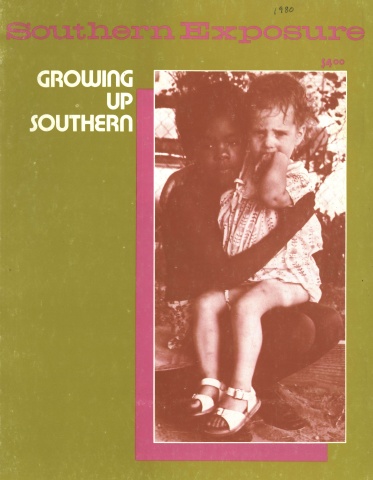Practical Friends and Godsends

This article originally appeared in Southern Exposure Vol. 8 No. 3, "Growing Up Southern." Find more from that issue here.
Child care has been and will remain a shared experience. As part of a study on employed mothers, five Alabama mothers — Carolyn, Mary, Kate, Janice and Anne — voiced their resentments, praise, wants, problems and solutions concerning child care.
All of these women’s pre-school-aged children receive full-time day care, through either a day-care center or an individual (non-relative). Money, or the lack of it, and the availability of relatives surfaced as two significant factors in the decision to use federally subsidized day care, private day care, hired in-home care or relatives and friends. However, the solutions these women found may change from day to day and from one child to the next. Mary explains, “I’ve left my children with my people, paid babysitters. . . . I’ve done something of everything.” Janice agrees: “There was a lot of juggling. Neighbors have helped me a lot. Mother lives nearby so if a child is sick, she can stay with her. . . . Mixtures of things. The best arrangement I ever had was a black woman whom I could really rely on.” A woman’s employer may add another choice to the assortment of possible arrangements, as Kate related: “I know women up there, married and single, with children, that leave on their breaks and go and pick up their kids, take them home or bring them to work with them and let them stay in the coffee shop until five o’clock.”
The most positive statements the mothers made were about day-care centers and hired housekeeper/care givers. Anne feels the care her child receives at a day-care center is reflected in the child’s behavior: “She seems to be more well-adjusted and not as fearful of strangers. She is just a real sociable child. I think that that’s a positive effect that comes out of the day-care center. I think that she’ll be happier also because of the experiences that she’s having that she wouldn’t have if it was just the two of us here.”
Two of the mothers, while married and with four children each, hired black women as housekeeper/care givers. Carolyn remembers, “She was really, really good. I decided that with my husband gone and nobody to help me, with one with colic and one just 12 months old, that no matter what it cost I was going to have her help me for awhile, and I did.” Janice’s relationship with the woman she hired went a bit further as they shared special events and conversation: “This sounds so benevolent Southerner, but Liz is actually a very real person to us. She’s not like a mother . . . it’s not a sister thing exactly, either. It’s more like a practical friend.” All of the women expressed strong concern for the lack of adequate, low-cost, after school and evening care. One woman explained, “I put two in nursery school, then what would I do with that seven-year-old in the afternoon? I’ve got to work. It so happened that there’s only one of me here and not another parent here and I have to worry about them when I’m away.”
The mothers did express some resentment or guilt about sending very young children to day care. Carolyn felt this intensely: “I hate to have children and have to go off and leave them eight to five. Little, tiny children; it just kills me. That may not bother the child as much as it does me.” And though Janice praises the black women who have cared for her children, she vows not to be removed from her children as her own mother was, entrusting them to the care of a nanny. Representative of ambivalent acceptance of day care is Mary’s comparison of mothering and day care. “When they’re small I know that quality care is important and there’s nothing like mothering, but also I know that you can find good day care and good facilities where the staff is — I wouldn’t say equivalent to mothering, that sounds sort of harsh — but quality staff who know how to care and provide well for children.”
One issue provoked no mixed feelings: the high cost of day care. One mother says she has limited the number of her children because she can not afford another child in day care. Carolyn complains that after weekly day-care costs are deducted from the wages she makes as a nursinghome aide, the day-care center would be making more money than she would. Her solution has been to attend college, with the help of loans and grants, where she is eligible for free child care and can also be home in the afternoons. For both Mary and Carolyn, federally subsidized and income-eligible child care has been a “godsend” and is a move most of these women heartily encouraged.
Several mothers suggested alternative solutions to eight-to-five center-based child care. Janice suggested kibbutz-like neighborhood groups and waiting centers at public schools for three-to-five o’clock care. Mary ventured two “really unrealistic thoughts”: reduced after-school child care prices and low-rent housing with a community day-care center for single working mothers.
All the mothers looked forward to one solution: time itself will take care of their child-care troubles. “I’m going to start seeing daylight,” Carolyn smiled. “It’s just a matter of marking time. I’ve gotten over the hump of small children. I’ve gotten them big enough that they’ll be in kindergarten, first grade. It’s just about over. After the nightmare I’ve been through, it’s going to be good. It’s got to be.”
Tags
Elaine Brockman-Jones
Elaine Brockman-Jones’ complete tapes, transcripts and paper on employed mothers are housed in the Alabama Archive of American Minority Cultures at the University of Alabama. Elaine is married, has a three-year-old son, and is now living in Atlanta, Georgia. (1980)